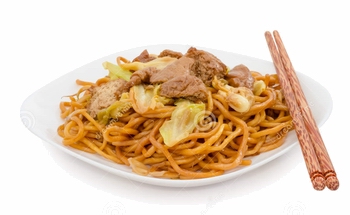|
Chinese cuisine includes styles originating from the
diverse regions of China, as well as from Chinese
people in other parts of the world.
The history of Chinese cuisine in China stretches
back for thousands of years and has changed from
period to period and in each region according to
climate, imperial fashions, and local preferences.
Over time, techniques and ingredients from the
cuisines of other cultures were integrated into the
cuisine of the Chinese people due both to imperial
expansion and from the trade with nearby regions in
pre-modern times, and from Europe and the New World
in the modern period.
|
|
 |
The Eight Culinary Cuisines of China are Anhui, Cantonese,
Fujian, Hunan, Jiangsu, Shandong, Szechuan, and Zhejiang
cuisines.
Prominent styles of Chinese cuisine outside China include
Singaporean, Malaysian, Indonesian, Indian and American, but
there is Chinese cuisine wherever Chinese people are found.
The staple foods of Chinese cooking include rice, noodles,
vegetables, and sauces and seasonings.
Chinese society greatly valued gastronomy and developed an
extensive study of the subject based on its traditional
medical beliefs. Chinese culture initially centered around
the North China Plain. The first domesticated crops seem to
have been the foxtail and broomcorn varieties of millet,
while rice was cultivated in the south. By 2000 BC, wheat
had arrived from western Asia. However, these grains were
typically served as warm noodle soups instead of baked into
bread as in Europe. Nobles hunted various wild game and
consumed mutton, pork, dog, and beef as these animals were
domesticated. Grain was stored against famine and flood and
meat was preserved with salt, vinegar, curing, and
fermenting. The flavor of the meat was enhanced by cooking
it in the fat of a different animal.
By the time of Confucius in the late Zhou, gastronomy was
becoming a high art. He was recorded discussing one such
picky eater: "For him, the rice could never be white enough.
When it was not cooked right, he would not eat. When it was
out of season, he would not eat. When the meat was not cut
properly, he would not eat. When the food was not prepared
with the right sauce, he would not eat." During Shi
Huangdi's Qin dynasty, the empire expanded into the south.
By the time of the Han Dynasty, the different climes and
cuisines of China's peoples were linked by major canals and
begun developing greater complexity. The philosophy behind
it was rooted in the I Ching and Chinese traditional
medicine: food was judged for color, aroma, taste, and
texture and a good meal was expected to balance the Four
Natures ('hot', warm, cool, and 'cold') and the Five Tastes
(pungent, sweet, sour, bitter, and salty). Salt was used as
a preservative from early times, but in cooking was added in
the form of soy sauce, and not at the table. The
predominance of chopsticks and spoons as eating utensils
also necessitated that most food be prepared in bite-sized
pieces or (as with fish) be so tender that it could be
easily picked apart. |



